
32% of shoppers in a recent Inmar Intelligence survey say they expect their coupon usage to increase over the next six months. Makes sense, on the heels of a rough year for coupons – since there’s just about nowhere to go but up.
As expected, Inmar’s annual look at coupon statistics from the previous year shows that couponing took a big hit during the height of the coronavirus outbreak in 2020. And yet, the downward trends don’t appear all that different from what they might have been even without a global pandemic.
Inmar found that slightly more than 200 billion coupons were distributed last year, down 15% from the year before. In percentage terms, that’s the steepest year-over-year decline ever recorded, representing the fewest total number of coupons issued in almost 40 years.
But when you consider that the previous year’s total was down 12.7% from the year before, which was down 11.7% from the year before that, you can’t blame last year’s slump solely on the coronavirus. Instead, it’s merely the continuation of a decline we’ve seen ever since coupon distribution hit a peak of 336 billion in 2010.
More alarming, perhaps, is the decline in coupon usage. While redemption volume decreased “only” 21% from the previous year, as compared to the steeper 24% decline in 2019, the 1.05 billion coupons redeemed last year represents the lowest total since way back in 1965. And it’s far, far from the 1992 peak of 7.8 billion coupons redeemed.
The one bright spot, depending on your perspective, is a noteworthy milestone for those who favor modernization and efficiency. For the first time ever, digital load-to-card coupons have surpassed newspaper free-standing insert coupons in popularity. Digital coupons accounted for the highest share of redemption volume last year, representing 29.3% of all coupons used, overtaking insert coupons, whose share dropped to 28%.
Of course, the pandemic has a little something to do with the depressed distribution and redemption figures, as well as the new supremacy of digital coupons. As panic-buying shoppers stocked up, and retailers and manufacturers scrambled to keep up with demand, coupons and promotions were among the last things on anyone’s minds around this time last year. Some stores stopped printing sales circulars altogether, while manufacturers scaled back their coupon offerings, and some retailers even stopped accepting paper coupons for a time.
But, in the end, the pandemic is only partly to blame for the shift in our couponing habits. The shrinking influence and reach of printed newspapers has a lot to do with it. “This decline is, for the most part, a reflection of reduced newspaper, and thus Free-Standing Insert (FSI), circulation,” Spencer Baird, Inmar Intelligence EVP & President, MarTech, told Coupons in the News. “As the most-distributed promotion method, changes in FSI promotion volume, which has accounted for roughly 90% of distribution for each of the past three years, dictates the direction of overall distribution trends.”
And depressed distribution naturally leads to lower redemption. “Rather than indicative of shoppers losing interest in promotions,” Baird said, “this shift is largely driven by lower paper redemption volumes resulting from decreased FSI volume,” as well as other factors like stricter coupon limits, as well as an increase in online shopping, where paper coupons are generally not accepted. Then there’s the simple fact that many coupon offers just aren’t that attractive, what with their shorter expiration dates, values that aren’t keeping up with prices, and the fact that they’re increasingly heavily skewed toward nonfood items that many shoppers are less interested in buying.
So how does this explain the growing popularity of digital coupons? Digital was quicker to recover from last year’s distribution declines, which means couponers had a better chance of finding deals digitally than in their Sunday newspaper inserts, which have longer lead times. And for those shoppers who are staying out of stores and ordering their groceries online for delivery or pickup, digital coupons are typically the only types that are accepted online. Add to that the fact that many coupon providers would love to get out of the inefficient and expensive printed coupon business and make all coupons digital, and it seems that consumer demand for digital discounts is finally catching up with much of the industry’s hopes and dreams for the very future of couponing.
“Digital is now a channel preferred across generations,” Baird said. “Digital coupons provide the most convenience and personalization… It is up to retailers to provide a wide range of digitally available value – and those that do will come out on top.”
Of course, many longtime couponers are wary of digital coupons, most of which can only be clipped and used once, at a specific retailer, and if they don’t come off your order correctly, there’s little you can do about it. And proponents of paper point out that printed coupons are far from dead, as alarmist headlines might have you believe. Digital coupons may be the most popular format, but when you combine Sunday insert coupons with coupons you print at home, get in the mail, in the store, on a product package, or via other physical methods, paper coupons still dominate. In total, 70.7% of all coupons redeemed last year were in some type of printed format, as compared to the 29.3% that were paperless.
So last year represented a landmark year for digital, if not for couponing as a whole. But digital still has a long way to go before it becomes the dominant coupon format. In the meantime, for the 32% of shoppers who expect their coupon use to increase this year, and for the rest who may be wishing that it will, we can only hope that last year’s historic lows turn out to be an aberration, and as life starts returning to its pre-pandemic normal – couponing will, too.
Image source: cpyles











I am a senior citizen, not too familiar with digital coupons.
Please let me know the best way to clip online the digital coupons.
I want the best sites www. and also adaptable to my browser, micro
soft edge… Thank You